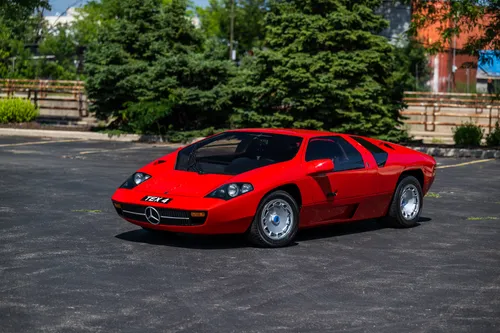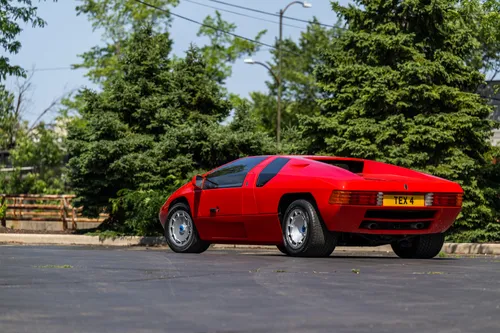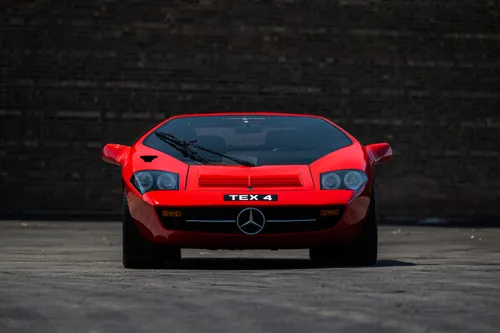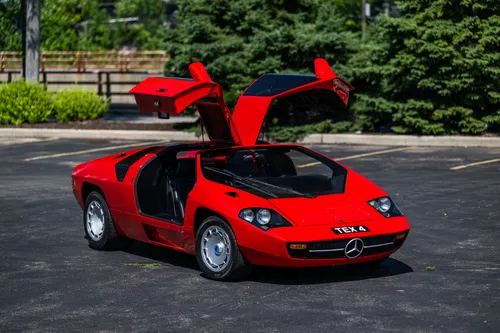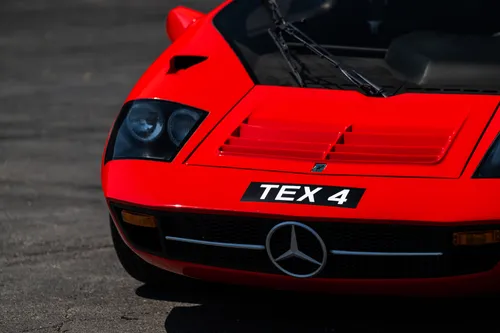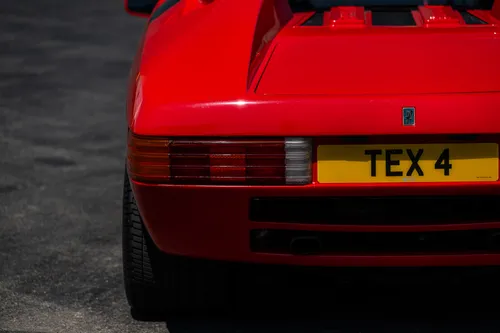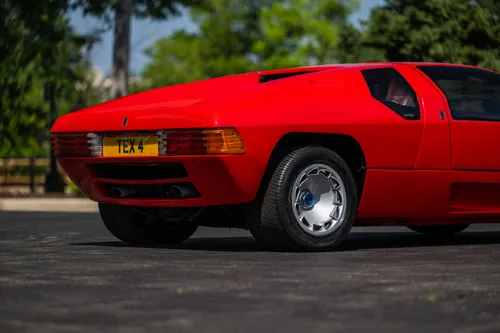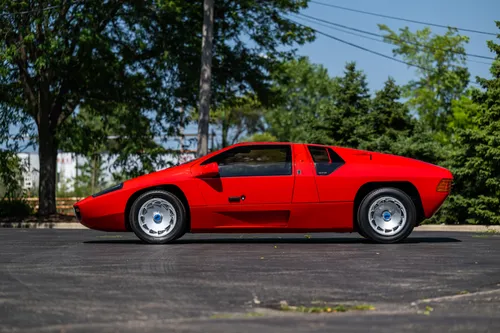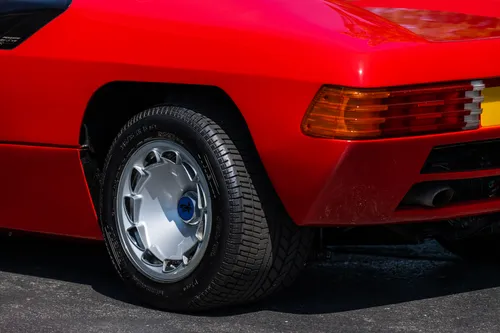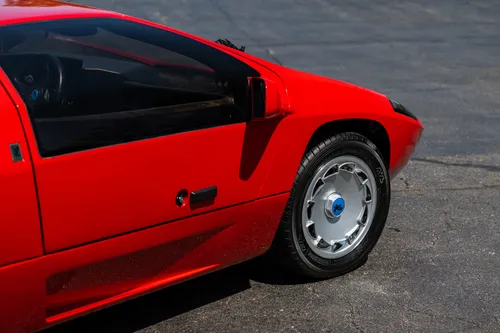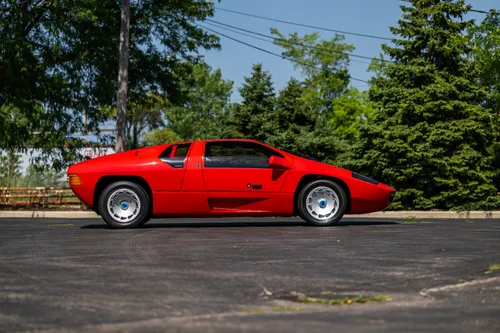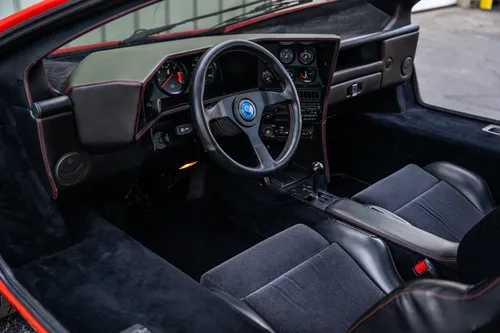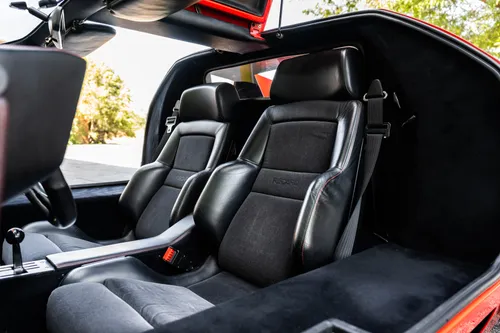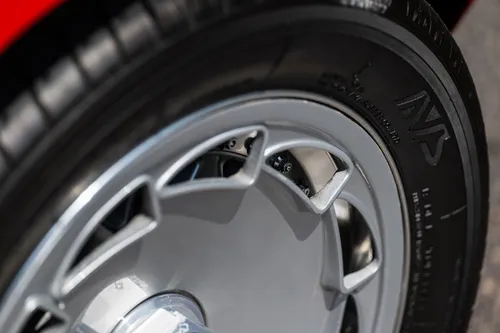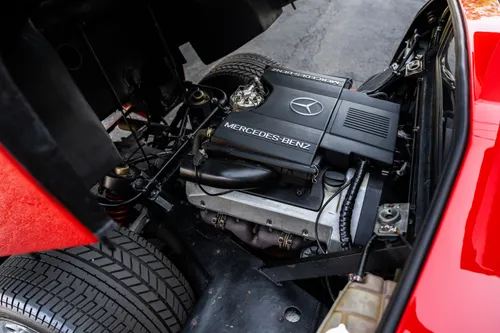- One of only 30 examples built; among the rarest supercars of its era
- Striking wedge-shaped design and Gullwing-style doors.
- Among the final examples of the 13 first series cars
- The only left-hand drive, UK-market example delivered
- Powered by 5.0-liter Mercedes-Benz V8
The annals of automotive history are full of countless visionaries — designers, engineers, and businessmen with daring, enterprising visions to strike out on their own and realize their own dreams of automotive glory. One need only think of modern-day luminaries such as Horacio Pagani or Christian von Koenigsegg to acknowledge the great feats of performance carried out by comparatively small start-up companies with a David-and-Goliath mentality. And while these visionaries are not uncommon, what is in fact quite rare is for the resulting car to be so competitive that it can take on the established supercars from Italian, Germany, and the United States.
Such is the story of Isdera and its Imperator 108i, which in a contemporary road test at Road & Track in 1987 on Volkswagen's Ehra-Lessien test track stunned the testers by sparring with the Lamborghini Countach 5000 QV and Alois Ruf's now-legendary CTR Yellowbird. Its Mercedes-Benz-derived V8 propelled the car to 60 mph in only five seconds, onward to a top speed of 176 mph — an extraordinary top speed for its time! So, what exactly was this Imperator? The Isdera concern was founded in 1982 by the German entrepreneur Eberhard Schulz with an acronym that translated states “Engineering Company for Styling, Design, and Racing.” His path to success in the automotive industry is certainly among the most atypical, as he constructed a home-built sports car in the late 1960s, named the Erator GTE, powered by a variety of engines and with clear design cues from the GT40 and Gullwing-style doors necessitated by the use of spaceframe construction. Driving the car to Porsche's and Mercedes-Benz's headquarters in search of employment, he was taken on by Porsche's styling and concept department where he remained for a number of years.
By 1978, having teamed up with Rainer Buchmann of b&b, the duo unveiled the CW311 concept car, a modern interpretation of the 300 SL Coupe and the forebearer of the car we see here today. While the car was powered by a Mercedes-Benz V8 and even had the company's blessing to wear the legendary three-pointed star, mass production was not forthcoming and so, Schulz, unfettered as always, ultimately struck out on his own, effectively forming Isdera with that express purpose in mind.
The vaunted Imperator 108i is what followed, a low-production supercar built from 1984 to 1993, in a total run of only 30 units. While little changed in concept from the original CW311, including the fiberglass body built in a steel spaceframe, the most noticeable design changes to the wedge shape were the elimination of pop-up headlamps and the replacement of the taillights with Mercedes-Benz units. Underneath the bonnet at the rear, the use of Mercedes-Benz V8s started with an M117 unit, mated to a ZF five-speed transmission, and ever-increasing displacement options as Mercedes further developed its V8 platform.
The Imperator 108i we have the pleasure of presenting here is a particularly fascinating and enticing example. Of the 30 examples built, 17 were completed after a design facelift was conducted for 1992, which included the return of pop-up headlamps and revised bodywork with added side vents, among other changes. As such, the first iteration of the Imperator design, about 13 cars, was only produced at a rate of between one and two cars per year. This particular car is one of the very last first-series cars, ordered at the start of 1990, according to a copy of its original Isdera vehicle data card on file. Handwritten notes on the same document reveal an anticipated delivery date of early 1991 to “Isdera-Japan”, although the ordering client is listed as Sunport London, Ltd. in the UK, “Concessionaire: M. Thackwell.” While it is known that at least one Imperator was delivered to Japan, Eberhard Schulz's response, on his own letterhead to a former owner indicates this was a “European model delivery to UK market.” In fact, a later advertisement for the car's offering suggests it was the only such example delivered to the UK and even refers to Thackwell as the actual owner.
Certainly the involvement of “M. Thackwell,” believed to be Mike Thackwell, is particularly interesting! A former racing driver from New Zealand, he perhaps most famous for being one of the youngest drivers to ever start a Formula One Grand Prix. While his motorsport career took various turns, from Formula 2, 3, and 3000, as well as sports cars (including a win at the Nürburgring 1,000 km race in a Sauber C8), he has since retired from racing altogether.
As for the car's specification, it is particularly desirable and attractive. The aforementioned data card, specifically mentions the car's 5.0-liter Mercedes-Benz M119 V8, “Code 960”, which of course was produced from 1989 to 1999, available in various displacements and in this configuration, put out well over 300 horsepower. Specified in “Porsche Indish Rot,” or Guards Red, the car presents in the very same color combination today, complemented by a black leather interior with Recaro bucket seats. By 2007 the car resided in the UK with Peter Hartnett of London and was registered with the number “TEX 4.” Since that time, the car has arrived stateside and been maintained in a highly regarded private collection, where it has kept company with some of the most exquisite supercars and racing cars in the world. It remains in very good condition and with an odometer reading of less than 3,500 kilometers, the car's state appears to be commensurate with a low-mileage car that has been well cared for.
Aside from posters on teenage bedroom walls or online videos of high-speed track days on European racing circuits, Isdera Imperators are rarely ever seen in public and are even more infrequently seen at auction. The offering of such an exceptional example, showing such low mileage, in such an attractive specification is particularly noteworthy. A classic wedge shape, the roar of a throaty Mercedes-Benz V8, and a classic five-speed transmission — contemporary supercars will surely just be a dot in the rearview mirror!



